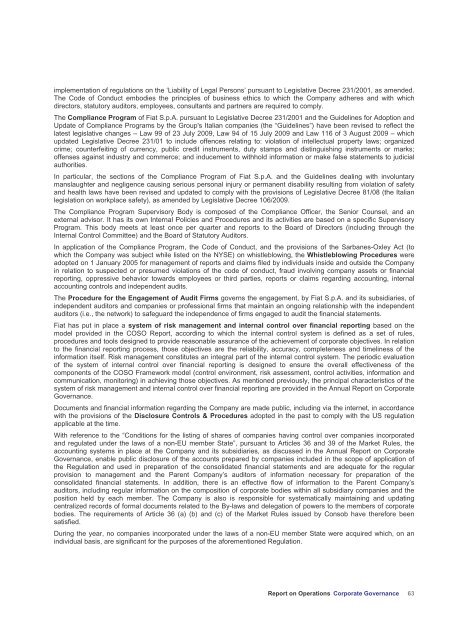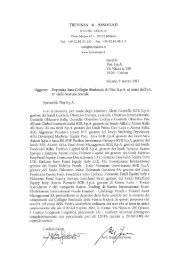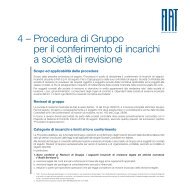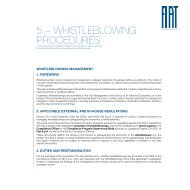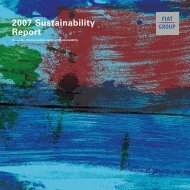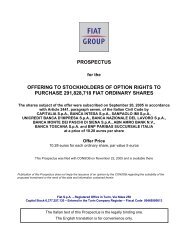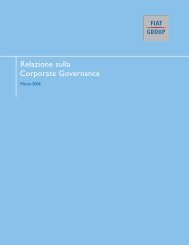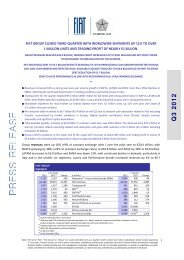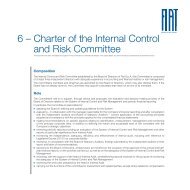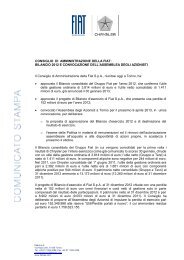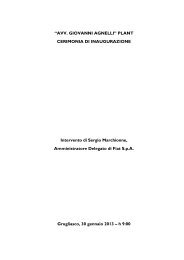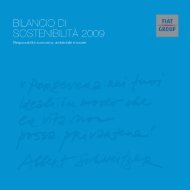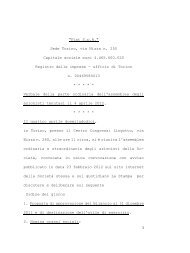annual report - FIAT SpA
annual report - FIAT SpA
annual report - FIAT SpA
Create successful ePaper yourself
Turn your PDF publications into a flip-book with our unique Google optimized e-Paper software.
implementation of regulations on the ‘Liability of Legal Persons’ pursuant to Legislative Decree 231/2001, as amended.<br />
The Code of Conduct embodies the principles of business ethics to which the Company adheres and with which<br />
directors, statutory auditors, employees, consultants and partners are required to comply.<br />
The Compliance Program of Fiat S.p.A. pursuant to Legislative Decree 231/2001 and the Guidelines for Adoption and<br />
Update of Compliance Programs by the Group's Italian companies (the “Guidelines”) have been revised to reflect the<br />
latest legislative changes – Law 99 of 23 July 2009, Law 94 of 15 July 2009 and Law 116 of 3 August 2009 – which<br />
updated Legislative Decree 231/01 to include offences relating to: violation of intellectual property laws; organized<br />
crime; counterfeiting of currency, public credit instruments, duty stamps and distinguishing instruments or marks;<br />
offenses against industry and commerce; and inducement to withhold information or make false statements to judicial<br />
authorities.<br />
In particular, the sections of the Compliance Program of Fiat S.p.A. and the Guidelines dealing with involuntary<br />
manslaughter and negligence causing serious personal injury or permanent disability resulting from violation of safety<br />
and health laws have been revised and updated to comply with the provisions of Legislative Decree 81/08 (the Italian<br />
legislation on workplace safety), as amended by Legislative Decree 106/2009.<br />
The Compliance Program Supervisory Body is composed of the Compliance Officer, the Senior Counsel, and an<br />
external advisor. It has its own Internal Policies and Procedures and its activities are based on a specific Supervisory<br />
Program. This body meets at least once per quarter and <strong>report</strong>s to the Board of Directors (including through the<br />
Internal Control Committee) and the Board of Statutory Auditors.<br />
In application of the Compliance Program, the Code of Conduct, and the provisions of the Sarbanes-Oxley Act (to<br />
which the Company was subject while listed on the NYSE) on whistleblowing, the Whistleblowing Procedures were<br />
adopted on 1 January 2005 for management of <strong>report</strong>s and claims filed by individuals inside and outside the Company<br />
in relation to suspected or presumed violations of the code of conduct, fraud involving company assets or financial<br />
<strong>report</strong>ing, oppressive behavior towards employees or third parties, <strong>report</strong>s or claims regarding accounting, internal<br />
accounting controls and independent audits.<br />
The Procedure for the Engagement of Audit Firms governs the engagement, by Fiat S.p.A. and its subsidiaries, of<br />
independent auditors and companies or professional firms that maintain an ongoing relationship with the independent<br />
auditors (i.e., the network) to safeguard the independence of firms engaged to audit the financial statements.<br />
Fiat has put in place a system of risk management and internal control over financial <strong>report</strong>ing based on the<br />
model provided in the COSO Report, according to which the internal control system is defined as a set of rules,<br />
procedures and tools designed to provide reasonable assurance of the achievement of corporate objectives. In relation<br />
to the financial <strong>report</strong>ing process, those objectives are the reliability, accuracy, completeness and timeliness of the<br />
information itself. Risk management constitutes an integral part of the internal control system. The periodic evaluation<br />
of the system of internal control over financial <strong>report</strong>ing is designed to ensure the overall effectiveness of the<br />
components of the COSO Framework model (control environment, risk assessment, control activities, information and<br />
communication, monitoring) in achieving those objectives. As mentioned previously, the principal characteristics of the<br />
system of risk management and internal control over financial <strong>report</strong>ing are provided in the Annual Report on Corporate<br />
Governance.<br />
Documents and financial information regarding the Company are made public, including via the internet, in accordance<br />
with the provisions of the Disclosure Controls & Procedures adopted in the past to comply with the US regulation<br />
applicable at the time.<br />
With reference to the “Conditions for the listing of shares of companies having control over companies incorporated<br />
and regulated under the laws of a non-EU member State”, pursuant to Articles 36 and 39 of the Market Rules, the<br />
accounting systems in place at the Company and its subsidiaries, as discussed in the Annual Report on Corporate<br />
Governance, enable public disclosure of the accounts prepared by companies included in the scope of application of<br />
the Regulation and used in preparation of the consolidated financial statements and are adequate for the regular<br />
provision to management and the Parent Company’s auditors of information necessary for preparation of the<br />
consolidated financial statements. In addition, there is an effective flow of information to the Parent Company’s<br />
auditors, including regular information on the composition of corporate bodies within all subsidiary companies and the<br />
position held by each member. The Company is also is responsible for systematically maintaining and updating<br />
centralized records of formal documents related to the By-laws and delegation of powers to the members of corporate<br />
bodies. The requirements of Article 36 (a) (b) and (c) of the Market Rules issued by Consob have therefore been<br />
satisfied.<br />
During the year, no companies incorporated under the laws of a non-EU member State were acquired which, on an<br />
individual basis, are significant for the purposes of the aforementioned Regulation.<br />
Report on Operations Corporate Governance 63


